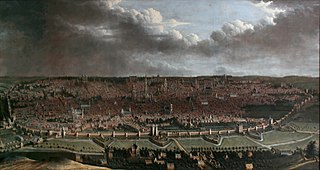Michiel Coxie the Elder, Michiel Coxcie the Elder or Michiel van Coxcie, Latinised name Coxius, was a Flemish painter of altarpieces and portraits, a draughtsman and a designer of stained-glass windows, tapestries and prints. He worked for patrons in the principal cities of Flanders. He became the court painter to successively Emperor Charles V and King Philip II of Spain.

Jan Siberechts (1627–1703) was a Flemish landscape painter who after a successful career in Antwerp, emigrated in the latter part of his life to England. In his early works, he developed a personal style of landscape painting, with an emphasis on the Flemish countryside and country life. His later landscapes painted in England retained their Flemish character by representing a universal theme. Siberechts also painted hunting scenes for his English patrons. The topographical views he created in England stand at the beginning of the English landscape tradition.

Maerten de Vos, Maerten de Vos the Elder or Marten de Vos was a Flemish painter. He is known mainly for his history and allegorical paintings and portraits. He was, together with the brothers Ambrosius Francken I and Frans Francken I, one of the leading history painters in the Spanish Netherlands after Frans Floris career slumped in the second half of the sixteenth century as a result of the Iconoclastic fury of the Beeldenstorm.

Jan Erasmus Quellinus was a Flemish painter and draughtsman and a member of the famous Quellinus family of artists. He was one of the last prominent representatives of the great Flemish school of history and portrait painting in the 17th century. His work displays the classicizing influences of his father Erasmus Quellinus the Younger and Paolo Veronese. Mainly active in his native Antwerp, he worked for some time in Vienna for the Habsburg court as a court painter to Emperor Leopold I.

Lucas van Uden was a leading Flemish landscape painter, draughtsman and engraver, who lived and worked in Antwerp. He was a leading landscape painter who collaborated with various local figure painters. His most original works are his drawings.

Charles Emmanuel Biset or Karel Emmanuel Biset was a Flemish painter who had a peripatetic career working in various cities and countries including his hometown Mechelen, Paris, Annonay, Brussels, Antwerp and Breda. He worked in many genres including genre scenes of interiors with merry companies and gallery paintings, history painting, still life and portraiture.

Anton Goubau or Anton Goebouw was a Flemish Baroque painter. He spent time in Rome where he moved in the circle of the Bamboccianti, Dutch and Flemish genre painters who created small cabinet paintings of the everyday life of the lower classes in Rome and its countryside. He is known for his Italianate landscapes and genre paintings in the style of the Bamboccianti and his history paintings with mythological and religious themes.

Nicolaas van Eyck or Nicolaes van Eyck, was a Flemish painter active in Antwerp in the middle of the 17th century. He is known for his equestrian and battle scenes, landscapes and portraits. He also painted a few civil processions, including parades of the Antwerp civil militia.

Jacob de Punder or Jacques de Punder, was a Flemish Renaissance painter mainly known for his portrait paintings.

Raphael Coxie, was a Flemish Renaissance painter mainly known for his portrait and history paintings.

Philips de Marlier was a Flemish Baroque painter and copyist mainly known for his still lifes of flowers and garland paintings.

Josse van der Baren was a Flemish painter of history paintings and a draughtsman active in the Leuven area around the turn of the 17th century.
Gommaert van der Gracht or Gommaer van der Gracht was a Flemish painter and draughtsman mainly known for his still life and landscape paintings.

Jan Anthonie Coxie or Anthonie Coxie was a Flemish painter and draughtsman mainly known for his portrait and history paintings. After starting his career in Flanders he moved abroad and worked in Amsterdam, Berlin, Mainz and Milan where he worked for an elite clientele.

Jan Baptist Bonnecroy or Jean Baptiste Bonnecroy was a Flemish painter and engraver known for his large panoramic city views and marine paintings.

Thomas de Paep was a Flemish painter who specialised in still lifes and in particular fruit still lifes. He was active in Mechelen.

Jan Willems was a Flemish painter of religious works as well as a polychromer and a designer of large figures used in processions. He was the city painter of Leuven where he spent his entire known career.

Willem Ignatius Kerricx was a Flemish sculptor, painter, draftsman, architect, engineer, playwright and author active in Antwerp in the first half of the 18th century. His sculptural works comprise mostly sculptured church furniture, individual sculptures, mainly statues of saints for churches and a few funerary monuments. His sculptural style is typical for the late Flemish Baroque while he shows a preference for Classicism in his architectural projects. He took over the large family sculpture workshop in Antwerp. As a painter he created both history paintings for churches and still lifes. He was also employed as an architect and engineer, mainly on reconstruction projects. In his youth, he composed a number of comedies and tragedies for the Antwerp theatre.
















